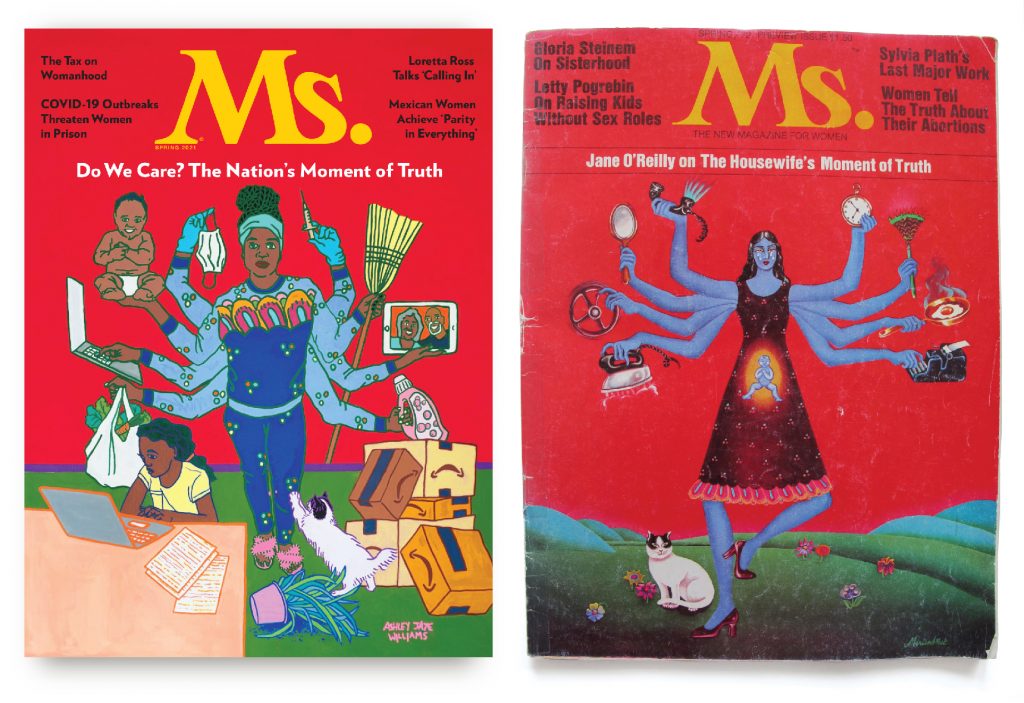The Sacrificial Religion of Feminism
The preview issue of Ms. magazine, founded by Gloria Steinem and published in 1972, had a curious image on its cover: a picture of the goddess Kali, and instead of a myriad of weapons in her many hands, which is the traditional Hindu depiction, she brandished items such as a typewriter and clothes iron—items usually associated with the typical post-war Western woman.
Why would a feminist publication choose to carry the image of a pagan deity like Kali with such a modern twist in its iconography? To understand the anthropological reason, an analysis of the traditional depiction is needed first, followed by a symbolic comparison with Christian iconography, which is equally essential.
It’s widely known that Steinem harbors a lot of irritation towards Christianity in particular. She remarked in an interview, “Monotheism makes me grouchy. I don’t trust any religion that makes God look like one of the ruling class. I guess I’m a pagan or an animist.”1 The insistence that Steinem is against all religions is heavily contradicted by her preference for paganism, and with this recognition, coupled with her other statements against churches, we can see where the image of Kali comes from. But of all the pagan gods and goddesses, why Kali?
The worship of Kali is popular among certain sects in the northern and eastern parts of India; it has an interesting history behind it which we will get to in a while. For now, let’s observe how she is portrayed. Kali is always depicted as having an extremely dark complexion with long black hair, and she is naked and barely covered by tiger skin around her waist and a garland of human heads around the bust. She has, like a lot of Hindu deities, multiple arms—sometimes four and sometimes as many as ten, all brandishing weapons while the remaining hands carry the decapitated head of an asura, the member of a demonic race, and a skull cup collecting the blood from the head.
In the classical posture, Kali is standing on the prostrate body of her consort Shiva. The mythological accounts tell the story of how Kali went on a destructive path and she could only be stopped by Shiva who lay down and allowed her to step on him, the result of which caused Kali to grieve and stick her tongue out in shame.
Myths are noted for having a tendency to obfuscate episodes of foundational violence, but in the case of Kali the violence seems to be obvious. It becomes even more certain when we consider the anthropological effects of the liturgy surrounding the iconography. Many classical writers of India have mentioned the element of human sacrifice surrounding the temples of Kali. One example is the ancient Kamakhya temple in the state of Assam in northwest India where, as recently as 2019, a headless body of a woman was found.2
We have to recognize that the seemingly universal frowning at violence is a modern concept. Had Steinem chosen the traditional depiction of Kali in her magazine, the typical American cosmopolitan housewife of the seventies, upon seeing it, would have been horrified. When we comprehend this, the Ms. magazine Kali, which replaces weapons for household items, becomes understandable. Violence in ancient traditions is not an evil but a paradoxical will of the divine. The nineteenth-century Hindu mystic, Ramakrishna, once asked why a person would worship Kali; he received this answer:
“Maharaj, when they are in trouble your devotees come running to you. But, where do you run when you are in trouble?”3
Once understood properly, we realize how brilliant this small anecdote is in explaining the origin of power structures around the world. Gloria Steinem, in the vein of Nietzsche, yearns for this very same hierarchy of old—this eternal recurrence or restoration of the old world order through continuous sacrificial violence. But Steinem’s disarming of Kali betrays the fact that she cannot carry out the violent reset, and it is simply because she cannot bring herself to do so. The peculiar post-Christian culture of her time prevents her from fully imitating Kali’s path of destruction. For her, whether she acknowledges it or not, the stumbling block is the iconography of Christ.

A 2021 recreation of the first Ms. magazine cover.
Now, why would the iconography of Jesus Christ be a stumbling block for a “pagan” like Gloria Steinem? What we have to understand here is that images are more than just images. Some experts say that the human eye can see as many as sixty frames per second.4 Our primary sensemaking is literally done through images, and our worldviews are shaped through this process. When we see the crucifixion of an innocent man, we are undoubtedly moved in one way or another. The Western world at large, despite its protestant sensibilities, has been shaped by the image of the crucifixion. The cross is burned into the collective psyche of the West, so much so that you see even materialists wearing it on their necks.
Oftentimes Christians run away from the similarities between pagan and Christian iconography; this is a mistake. There is a mistaken assumption that similarities make the argument for sameness. This is not true, as we will see. Similarities can often be attributed to polar opposites conveyed through a single medium, or they can be the unifying element of a subject and its subversion. The theme of violence is heavily present in both the images of Kali and the crucifixion of Christ, but there is a marked difference: Kali is the provider of violence whereas Christ is the receiver.
Oddly enough, another major similarity that is shared between the two images is the juxtaposition of self-sacrifice against sacrifice of another. But in that similarity, there is yet another difference. In the image of Kali, the chaotic feminine is stopped by the divine masculine, and the crucifixion image, as if zeroing in on that aspect of the self-sacrificial masculine, presents Christ as the ultimate male dying on the cross while the feminine, in the form of a mother, laments at the foot of the cross. In the Kali image, the feminine is a destructive force of nature that needs to be checked by masculine energy. In the crucifixion image, the masculine and feminine are self-sacrificial co-participants in the redemption of humanity. In other words, Gloria Steinem should have stuck to the classical image of Kali on her magazine, for in her toothless, disarmed version, she trivialized the unveiling of sacrificial violence.
It is this refusal to see the unveiling of mythic violence by the Gospel story that forms the core of societal stagnation. Feminists today, in the tradition of Gloria Steinem, want to see the resurgence of pagan values, but they are unable to fully commit to their cause because the crucifixion of Christ has made it impossible for them to do so. If we see the image of Kali, our subconscious minds instantly compare it to the image of Christ dying on the cross, and as a result, we are unable to escape the Christian infection that has permeated the root of our culture.
What feminists often complain about is this idea of the residue from the old order of what they like to call “the patriarchy” and how it still casts a shadow over modern society. They would be surprised to know that this thing called “the patriarchy” is the ancient might-makes-right way of operating coercive power structures, and, as the human sacrifice stories from India reveal, it scapegoats both the feminine as well as the masculine. By placing household objects into the hands of Kali and appeasing the cosmopolitan ladies of the West, Steinem and her feminist movement flee from the ultimate reality, i.e. the sacrificial violence of the other that oppressive man-made structures existentially rely upon.
In this act of fleeing from Jesus’ unveiling of sacrificial violence, the feminist movement becomes the new sacrificial religion wherein the human female is taken away from redemption, placed back into the chains of nature, emptied of personality, emptied of God’s image, and sold into the modern-day oppressive machine; and the only “transcendent” thing they are left with is the worship of desire.
We are at a crossroads where human beings must collectively come to a decision: either we can keep producing new myths of half-truths and satisfy our egos while millions of people divide and victimize themselves, or we can fully embrace the radical trajectory that Jesus has set us on and become willing participants in His mission to free ourselves from hatred and rivalry. Perhaps this is why the last book of the Bible, foreseeing our ability to choose the correct path, presents to us the image of a wedding in a new and magnificent city.5
- https://www.theguardian.com/world/2005/jan/17/gender.melissadenes
- https://www.thehindu.com/news/national/other-states/headless-body-of-woman-found-near-kamakhya-temple/article28078990.ece
- Saradananda, Swami (1952). Sri Ramakrishna:The Great Master. Ramakrishna Math
- https://www.healthline.com/health/human-eye-fps
- See Revelation 21:1-2
Buy Surit Dasgupta’s book The Reenchanted here.












Leave a Reply
Want to join the discussion?Feel free to contribute!